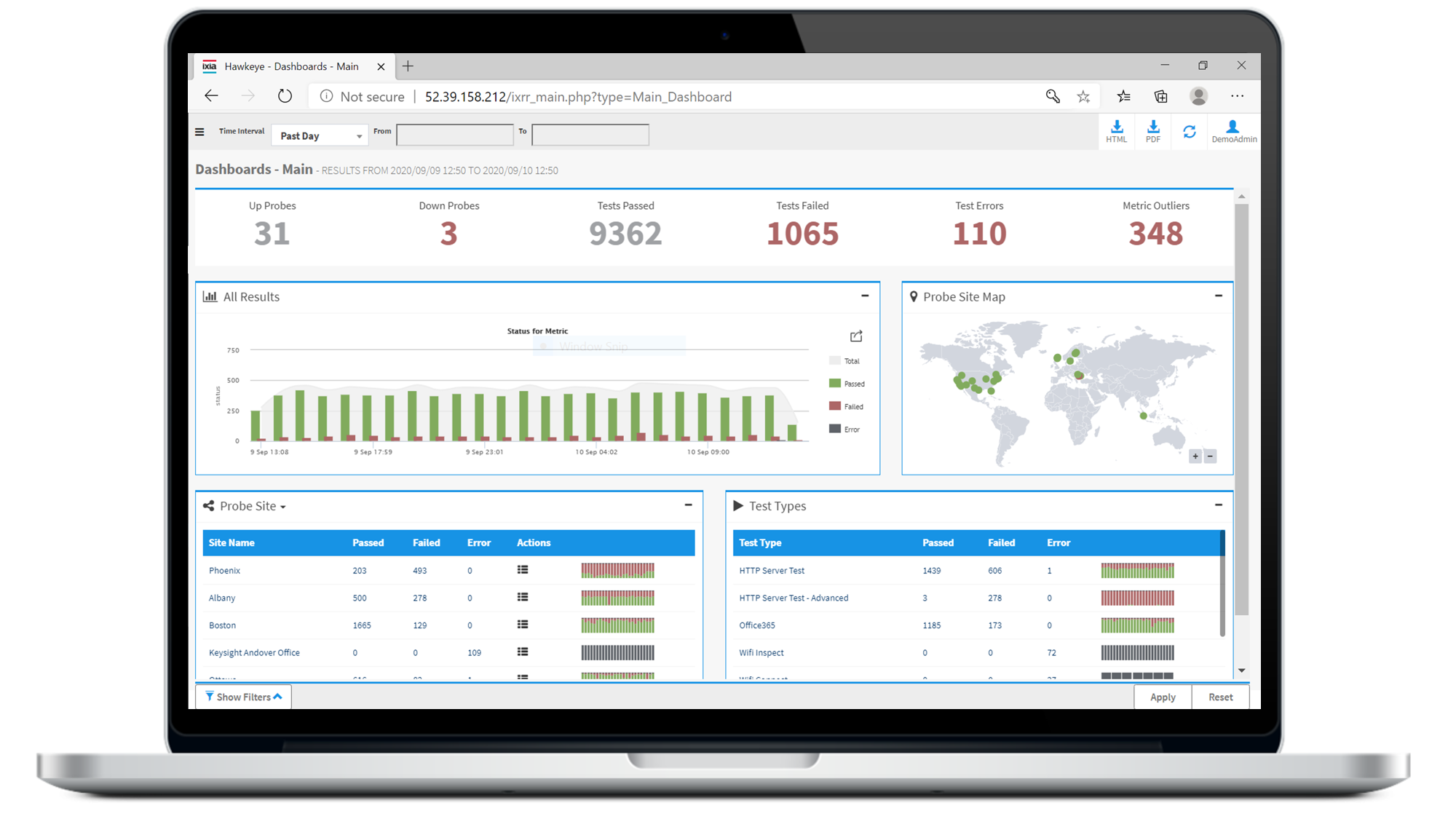무엇을 찾고 있습니까?
어플리케이션 및 네트워크 성능 모니터링
합성 애플리케이션 모니터링(APM) 및 네트워크 성능 모니터링(NPM) 도구로 네트워크와 어플리케이션의 품질과 성능을 개선하기 위해 모니터링합니다.
네트워크 성능 모니터링이란?
네트워크 성능 모니터링(NPM)과 애플리케이션 모니터링(APM)을 통해 비즈니스 어플리케이션의 품질과 성능을 저하시키는 요인을 방지하기 위해 네트워크 성능 검사와 트래픽을 시뮬레이션하고 응답 시간을 추적합니다. 이를 통해 엔지니어는 어플리케이션 및 네트워크의 문제를 신속하게 파악하고 문제를 해결할 수 있습니다.
합성 네트워크 성능 모니터링을 통한 중단 최소화
합성 네트워크 성능 모니터링(NPM)과 어플리케이션 성능 모니터링(APM) 도구는 실제 트래픽을 시뮬레이션하고 네트워크, 웹 사이트, 어플리케이션에서 응답 시간을 추적하여 사용자보다 먼저 문제를 발견할 수 있습니다.
키사이트 네트워크 및 어플리케이션 성능 모니터링 소프트웨어 살펴보기
합성 모니터링이란?
라이브 네트워크와 어플리케이션 트래픽에 의존하는 실제 사용자 모니터링(RUM) 도구와는 다르게, 합성 모니터링 도구는 시뮬레이션된 어플리케이션 트래픽을 생성하고 네트워크 및 어플리케이션으로 전송한 후 의도한 목적지에 도달하는 데 소요되는 시간을 측정합니다. 계속 반복되는 테스트를 통해 네트워크 운영 및 어플리케이션 딜리버리 팀은 다양한 조건에서 QoE와 서비스 품질(QoS)을 모니터링하여 서비스 품질 저하, 네트워크 / 어플리케이션 지연, 병목 현상 관련 위치를 정확하게 파악할 수 있습니다.
합성 APM 및 NPM 도구로 어떠한 작업을 수행할 수 있습니까?
네트워크 지연 방지 및 일관된 QoS 보장
병목 현상, 지연, Wi-Fi 장애를 비롯해 정확하게 잡아내기 힘든 문제들이 네트워크 서비스(예: 통합 통신, VoIP, SaaS, 비즈니스 어플리케이션)의 품질과 성능을 저하시키는 것을 방지하십시오. Hawkeye는 예정된 검증 테스트를 실행하고 다양한 실제 트래픽 부하와 상호 작용, 어플리케이션 조합을 에뮬레이션하여 네트워크 성능을 모니터링하고 문제를 격리시키고 이슈를 사전에 감지합니다. AI 기반 이상점 감지 및 합격 / 불합격 지표는 문제 해결 우선순위를 지정하는 데 도움이 되고, 홉바이홉(hop-by-hop) 분석을 통해 쉽게 근본 원인을 분석하고 문제가 되는 부분을 수정할 수 있습니다.

모든 모바일 사용자를 위해 일관적인 경험 유지
모바일 어플리케이션과 웹 사이트 전반에서 QoS를 유지하려면 단순히 전통적인 방식으로 어플리케이션 성능을 모니터링하는 것으로는 부족합니다. 디바이스, 운영 체제 등의 광범위한 변수를 관리해야 합니다. Eggplant Monitoring은 Apple 및 Android 환경에서 화면 해상도, 업로드, 다운로드, 네트워크 지연을 에뮬레이션하여 액세스 가능한 모든 시스템, 웹 사이트, 어플리케이션에서 일관적인 모바일 경험과 기능을 보장할 수 있습니다.

더 빠른 문제 해결과 코어에서 에지에 이르는 서비스 품질 최적화
복잡한 토폴로지와 사각지대가 분리된 하이브리드 네트워크에서 QoS를 유지하는 역량에 영향을 미치지 않도록 하십시오. 주요 컴퓨팅 리소스와 워크로드가 클라우드에서 네트워크의 에지로 이동함에 따라, 네트워크 운영 팀은 합성 NPM 도구를 통해 성능 저하 문제를 감지하고 근본 원인을 격리해야 합니다. 광범위한 하드웨어 및 소프트웨어 기반 네트워크 엔드포인트를 보유한 Hawkeye는 코어에서 에지에 이르는 포괄적인 서비스 검사를 수행할 수 있습니다. 그와 동시에 노드-노드 트래픽 시각화가 문제 해결을 가속하고 현장 출장 횟수를 최소화합니다.
사용자의 관점에서 웹 사이트와 앱 모니터링
대규모 JavaScript 파일, 압축되지 않은 이미지, 동영상과 같은 웹 기반 성능 저하 문제를 최소화합니다. Eggplant Monitoring은 사용자 동작을 에뮬레이션하고 계속해서 로드 시간, 다운로드 속도, 그 외 UX 관련 성능 지표를 웹 사이트와 어플리케이션에서 테스트합니다. 클라이언트측 요인(다시 시도 논리와 가변적 파라미터화)과 백엔드 상호 작용(예: API, 모바일, FTP, 2단계 인증)을 시뮬레이션하여 고객 여정을 시각화하고 병목 현상을 파악하고 최적화 기회를 식별합니다.
솔루션 요약 읽기
최적의 성능을 위한 웹 사이트 모니터링

혁신적인 테스트 자산 보호
어플리케이션 및 네트워크 성능 모니터링 소프트웨어 관련 자주 묻는 질문
What is network performance monitoring (NPM)?
Network performance monitoring (NPM) tools enable you to visualize, monitor, troubleshoot, and maximize a given network's performance, availability, and quality of service.
These tools operate one of two ways: reporting live network traffic or generating synthetic traffic and sending it across the network to various hardware- or software-based endpoints. Frequently, these tools display critical metrics and KPIs such as packet loss, jitter, delay, response time, and mean opinion score. A highly-visual, real-time dashboard utilizing AI or machine learning makes it easy for network operations teams to identify outliers and potential issues to follow up on.
What is application performance monitoring (APM)?
Application performance monitoring (APM) tools enable IT personnel and DevOps teams to ensure enterprise and customer-facing applications meet users' expected performance, reliability, and user experience (UX) goals.
APM tools generally fall into one of two categories: real user monitoring (RUM) or synthetic monitoring. RUM platforms capture and report on traffic metrics and performance checks derived from real application users — providing real-time insights into UX and performance. Conversely, synthetic monitoring tools emulate user interactions to benchmark application performance under various conditions and scenarios — enabling operations teams to identify and remediate potential bottlenecks faster.
What is synthetic monitoring?
Traditional monitoring tools rely on actual traffic data, sometimes called passive data. Synthetic monitoring (active monitoring) tools generate simulated application traffic, inject it into your network, and capture key performance indicators. Running simulations lets you observe your network's performance under various conditions and note where performance does not meet expectations.
The process is active because you control the type and mix of applications and the traffic volume in each simulation. Since your monitoring tool is not dependent on live traffic, you can anticipate performance problems and test the impact of potential fixes. You move from being passive and reactive to being proactive.
How can you use synthetic monitoring tools?
Synthetic monitoring is excellent for assessing network readiness before deploying SD-WAN, distributed unified communications, cloud applications, or voice and video services like Microsoft Teams or Zoom. Since these tools rely on simulated traffic to measure response time, quality, or latency, you can predict performance and pinpoint bottlenecks before going live. Moreover, most industry-leading tools offer a library of application signatures — enabling you to build highly accurate tests with the exact type of traffic you expect while varying the volume to model changes in demand.
A flexible monitoring platform lets you simulate traffic from various endpoints across your distributed network, so that you can measure performance in a wide range of operating scenarios. You can test node-to-node connections in a distributed network, validate end-user experience using cloud-based applications, or ensure large-scale network deployments are ready for release.
In addition to pre-deployment and live network assessments, you can also use continuous active monitoring to proactively maintain QoS. Tracking daily simulation results makes it easy to identify deviations from the norm — giving you an early indication of when performance falls below minimum service levels.
다른 도움이 필요하십니까?






